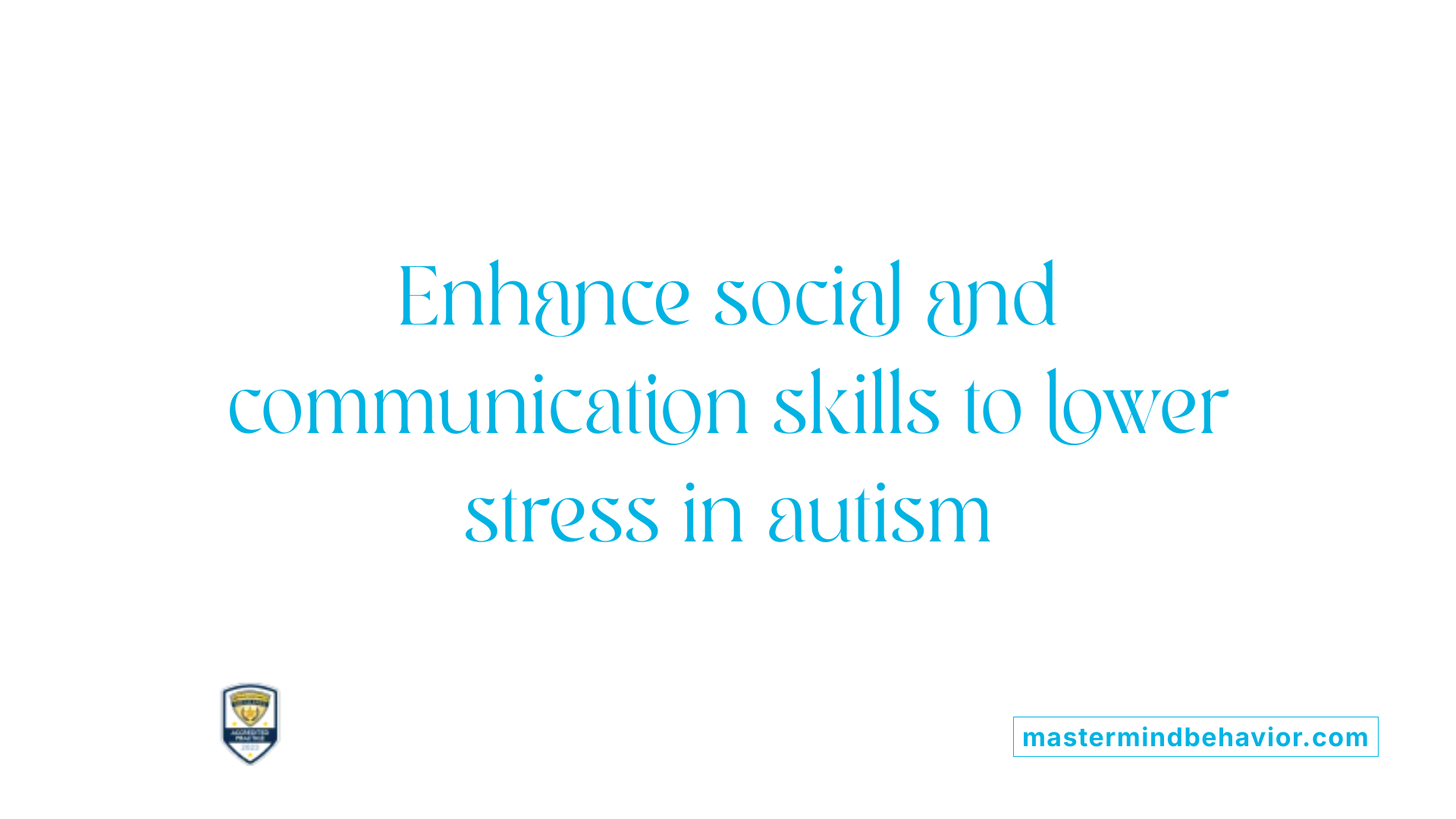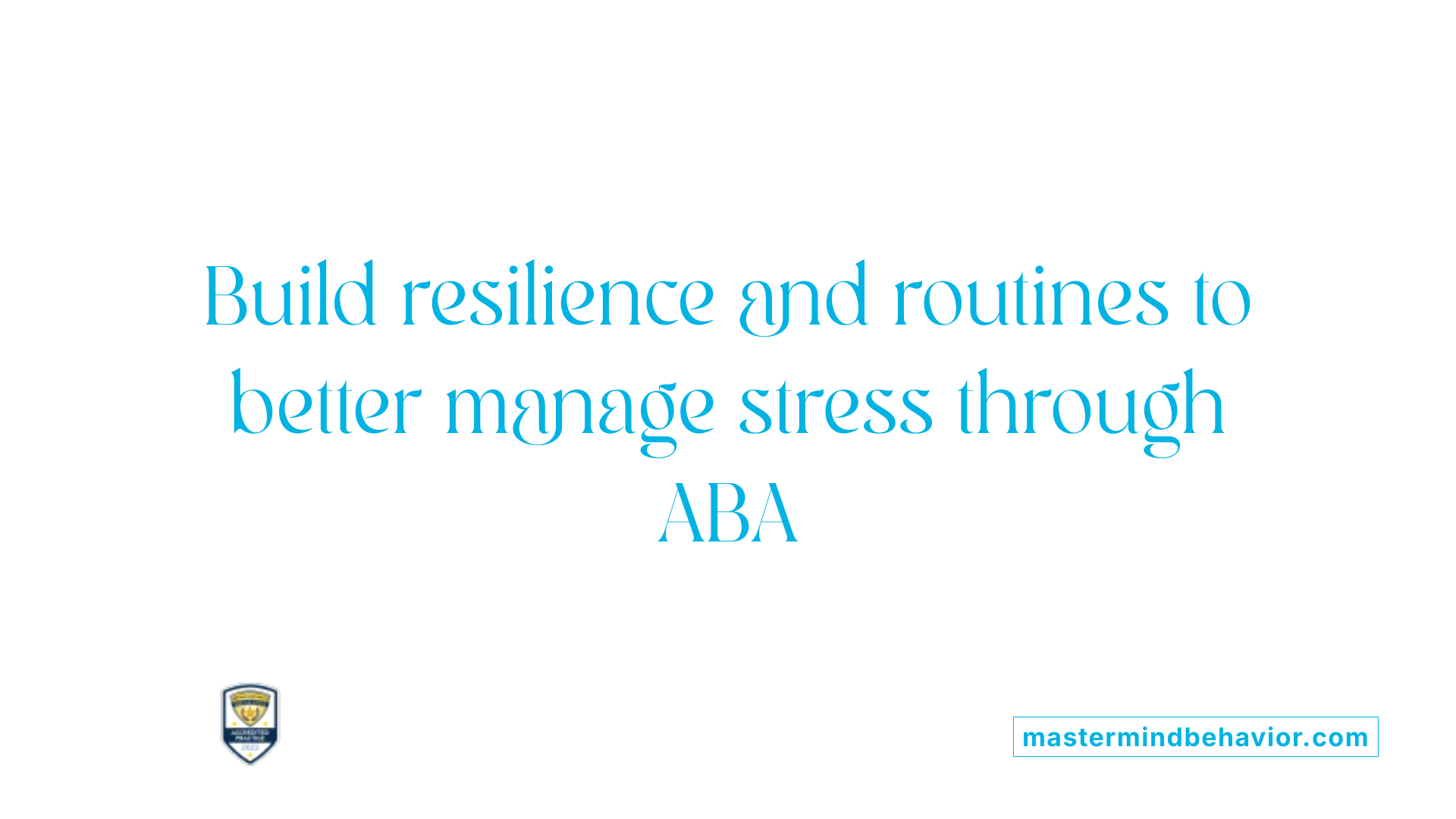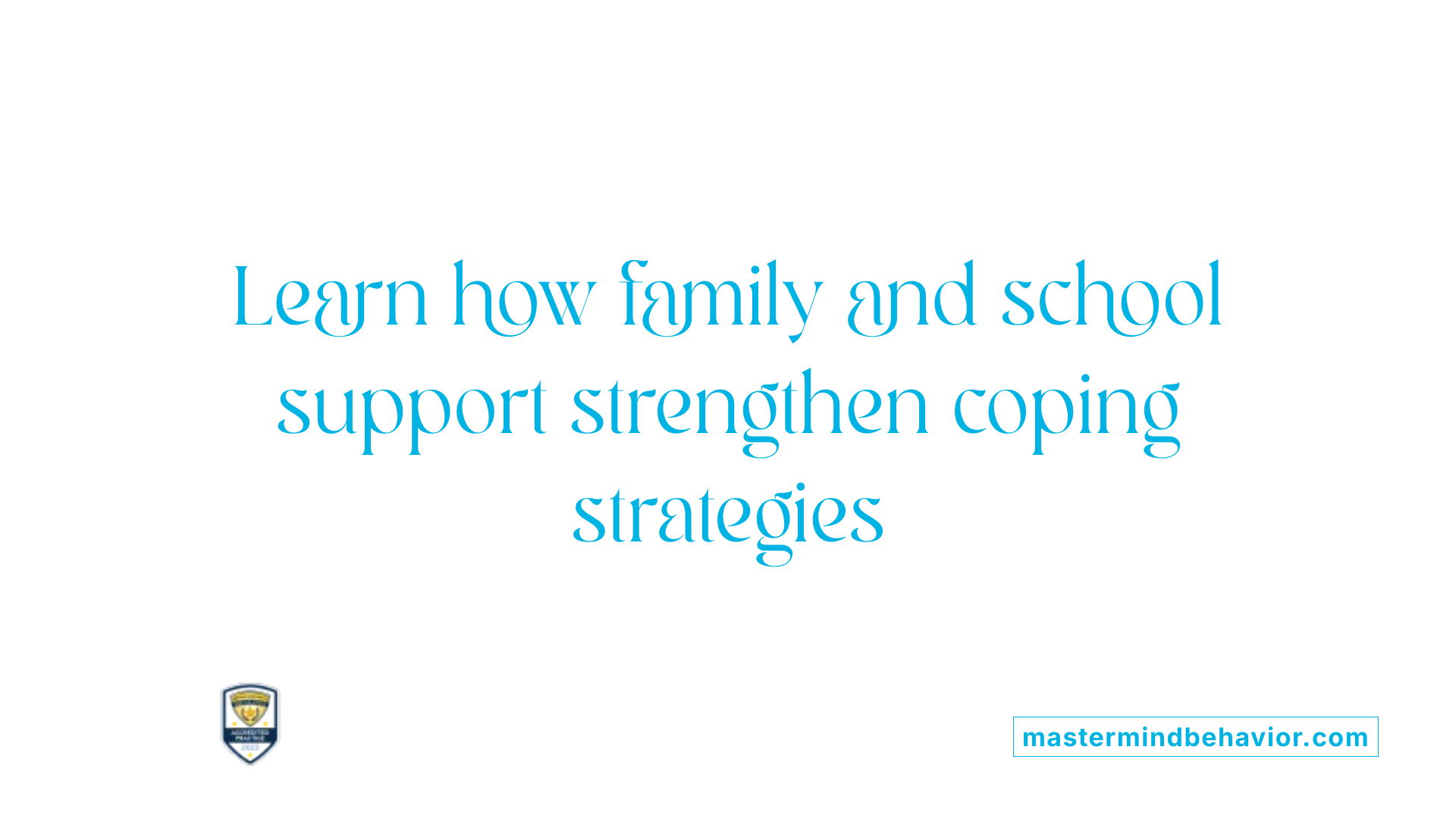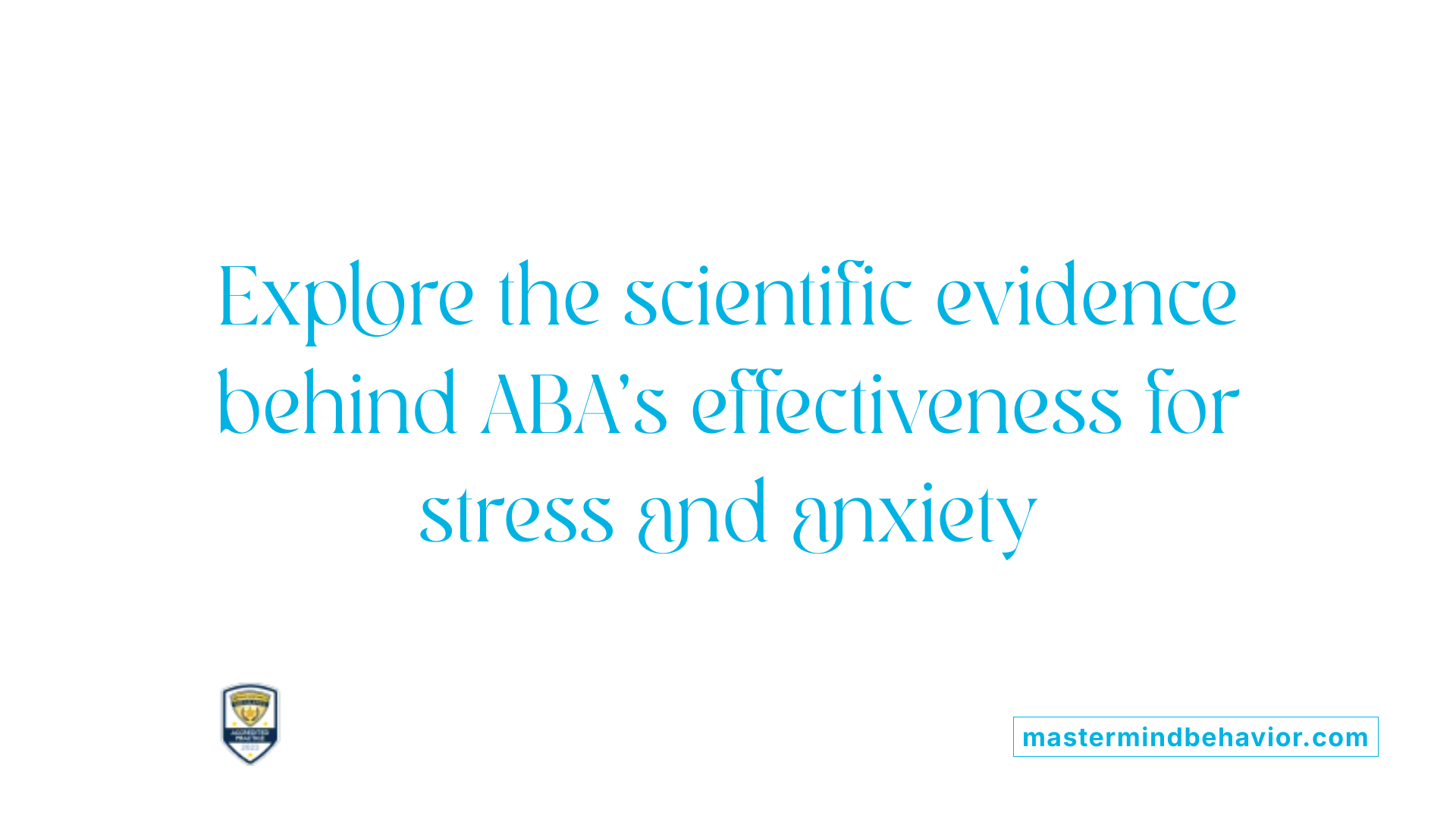Understanding ABA Therapy in Autism Treatment
Applied Behavior Analysis (ABA) therapy is a cornerstone behavioral intervention designed specifically to support individuals with autism. Rooted in the science of learning and behavior, ABA therapy offers a structured and individualized approach that helps increase adaptive behaviors such as communication, social skills, and daily living abilities while reducing behaviors that interfere with learning or quality of life. This article explores how ABA therapy specifically aids in teaching coping strategies during stressful situations, providing autistic individuals with tools to manage anxiety and enhance their overall well-being.
What Is ABA Therapy and How Does It Support Individuals with Autism?
What is Applied Behavior Analysis (ABA) therapy in the context of autism treatment?
Applied Behavior Analysis (ABA) is a scientifically validated therapy primarily used to support individuals with autism by understanding behavior and the environmental influences on it. ABA aims to increase helpful behaviors, including communication, social skills, and daily living abilities, while reducing harmful or interfering behaviors.
How do BCBAs and individualized treatment plans play a role?
A Board Certified Behavior Analyst (BCBA) oversees ABA therapy, conducting detailed assessments to develop individualized treatment plans tailored to the unique needs of each person. These plans are goal-oriented and evolve based on ongoing data collection and progress monitoring.
What techniques are commonly used in ABA?
ABA employs methods such as positive reinforcement to encourage desirable behaviors. It also utilizes discrete trial training (DTT), which breaks skills into small, manageable steps for teaching, and naturalistic teaching strategies that promote learning within typical environments and daily activities.
What are the goals related to independence, communication, and social skills?
The overall goal of ABA therapy is to foster independence by enhancing communication abilities and social interactions. By building these foundational skills, ABA supports autistic individuals in participating more fully in their communities and improving their quality of life.
Primary Goals of ABA Therapy for Autism
What are the main goals of ABA therapy for individuals with autism?
ABA therapy primarily aims to increase socially significant behaviors such as communication, social skills, academic abilities, and daily living skills. These improvements help individuals with autism become more independent and successful across various environments.
Another important goal is to reduce behaviors that interfere with learning or negatively affect quality of life. By decreasing these harmful or disruptive behaviors, ABA supports better engagement and well-being.
Promoting functional skills is central, equipping individuals with practical abilities like problem-solving, assertiveness, and effective communication. These skills enable greater autonomy and social participation.
Ongoing assessment and individualized goal-setting are critical components. A qualified therapist continuously monitors progress through data collection and feedback, tailoring interventions to each person's unique needs. This ensures that treatment remains effective and focused on meaningful outcomes.
ABA uses evidence-based strategies such as positive reinforcement, discrete trial training, modeling, and functional communication training. These techniques help modify environmental influences on behavior and promote lasting positive change.
Overall, ABA therapy strives to enhance the quality of life for individuals with autism by fostering independence, social integration, and adaptive functioning.
Who Provides ABA Therapy Services?
Who typically provides ABA therapy services?
ABA therapy is usually delivered by licensed or certified professionals trained in behavior analysis. The primary providers are Board Certified Behavior Analysts (BCBAs), who are responsible for creating and overseeing individualized treatment plans tailored to each person's needs.
In practice, BCBAs often supervise the work of registered behavior technicians (RBTs) and licensed therapists. These professionals implement the day-to-day therapy sessions based on the BCBA's design and recommendations.
Treatment typically takes place in various environments, including clinics, specialized centers, schools, and sometimes the individual's home. Many ABA providers work within multidisciplinary teams to coordinate care and ensure comprehensive support.
Family involvement is a crucial aspect of effective ABA therapy. Providers train parents and caregivers on how to reinforce skills and apply interventions consistently outside of therapy sessions. This ongoing guidance helps maintain progress and promotes generalization of learned behaviors.
To ensure quality and effectiveness, therapy is regularly monitored through data collection and progress assessments by the BCBA. This supervision allows for adjustments to the intervention as needed, optimizing outcomes and supporting continuous improvement.
ABA Therapy Techniques Used to Teach Coping Skills During Stress

How does ABA use positive reinforcement and basic principles?
ABA therapy emphasizes positive reinforcement, rewarding desired behaviors to increase their frequency. This principle helps individuals learn adaptive coping skills by encouraging more frequent use of effective strategies under stress. It also includes the ABC model—Antecedent, Behavior, Consequence—to understand triggers and outcomes, allowing therapists to alter environments and reinforce better responses.
What role does behavioral activation play in managing anxiety?
Behavioral activation (BA), a primary ABA technique for treating anxiety, focuses on reducing avoidance behaviors. By encouraging engagement in meaningful, adaptive activities, BA helps individuals confront anxiety triggers gradually, decreasing fear responses. Techniques such as graded exposure—like driving with support to lessen traffic anxiety—illustrate how BA introduces healthy coping through positive reinforcement of successful experiences.
What skill-building exercises are involved?
ABA therapy includes training in problem-solving, assertiveness, and communication skills. Practical exercises like role-playing and mental rehearsal prepare individuals to handle stressful social and environmental challenges. Enhancing these skills helps reduce anxiety and builds confidence in managing stressful situations.
How are mindfulness, deep breathing, and relaxation techniques integrated?
Mindfulness and self-regulation strategies such as deep breathing and relaxation exercises are embedded into ABA sessions to improve emotional control. These techniques aid in calming physiological anxiety symptoms like elevated heart rate and shortness of breath, thus complementing behavioral strategies with direct stress management tools.
How do role-playing and mental rehearsal aid coping skill development?
Role-playing simulates stressful scenarios, allowing individuals to practice appropriate responses in a safe environment. Mental rehearsal helps prepare for real-world situations by visualizing success. Both techniques reinforce new coping behaviors through repetition and positive feedback.
What visual and sensory supports are used?
Visual supports like schedules and cues enhance predictability and understanding, reducing stress from unexpected changes. Sensory integration techniques address sensitivities common in autism, helping individuals regulate their sensory input to prevent overload and promote comfort.
| Technique | Purpose | Examples |
|---|---|---|
| Positive Reinforcement | Increase desired coping behaviors | Rewarding deep breathing after stress onset |
| Behavioral Activation | Reduce avoidance and increase engagement | Graded exposure to anxiety triggers |
| Skill-building Exercises | Develop social and problem-solving abilities | Role-playing assertiveness scenarios |
| Mindfulness and Relaxation | Enhance emotional regulation | Deep breathing, guided relaxation |
| Role-playing and Mental Rehearsal | Practice coping responses | Simulated social interactions |
| Visual Supports and Sensory Integration | Provide structure and reduce sensory overload | Visual schedules, sensory breaks |
Addressing Anxiety and Stress Through Behavioral Activation in ABA
What Are Anxiety Triggers and Avoidance Behaviors?
Anxiety is often triggered by certain stimuli that cause discomfort, such as specific situations or thoughts. These triggers can lead to avoidance behaviors, where a person intentionally stays away from the anxiety-provoking situation to reduce distress.
How Does Behavioral Activation Help?
Behavioral activation (BA) is a treatment method used in ABA that helps individuals face anxiety by increasing their participation in healthy, adaptive activities. Instead of avoiding triggers, individuals learn to engage more with activities that bring pleasure or mastery, promoting positive change.
What Is the ABC Model in ABA?
The ABC model stands for Antecedent, Behavior, and Consequence. It explains how anxiety triggers (Antecedents) lead to particular behaviors (often avoidance), which then have consequences that either reinforce or reduce these behaviors. ABA interventions focus on changing these patterns to reduce anxiety.
How Does Graded Exposure Work? Example with Driving Anxiety
Graded exposure is a technique where anxiety-provoking activities are approached gradually and systematically. For example, a person anxious about driving and conditioned to associate traffic with a heart attack might start by driving short distances with a support person. Through repeated, supported exposure and positive reinforcement for successful drives, anxiety symptoms can lessen and eventually disappear.
How Does Reinforcement Reduce Anxiety Symptoms?
ABA employs positive reinforcement to encourage approach behaviors and successive approximations toward confronting feared situations. This helps decrease anxiety symptoms such as elevated heart rate and trembling by building confidence and coping skills.
Through structured ABA strategies, including behavioral activation and graded exposure, individuals learn to manage anxiety effectively by replacing avoidance with engagement and reinforcing successful coping.
Building Communication and Social Skills to Reduce Stress in Autism

How Does Improving Expression of Overwhelm and Needs Help?
Individuals with autism often face challenges expressing when they feel overwhelmed, which can increase stress levels. ABA therapy focuses on enhancing their ability to communicate these feelings effectively. By using techniques such as role-playing and skill-building exercises, individuals learn to recognize and express their needs, which reduces anxiety linked to unmet or misunderstood needs.
How Does ABA Enhance Social Interaction Abilities?
ABA therapy employs social skills training to boost interaction. It teaches crucial skills like initiating conversations, maintaining eye contact, turn-taking, and understanding social cues. Improving these skills fosters positive social engagement, making social situations less intimidating and more rewarding.
How Does This Reduce Social-Related Stress and Isolation?
When individuals with autism improve their communication and social skills, they often experience lower social-related stress. This leads to reduced feelings of isolation since they can participate more comfortably in social settings. Effective communication acts as a bridge to better relationships, providing emotional support.
How Is Communication Used as a Coping Tool?
Communicative abilities serve as essential coping mechanisms in stressful situations. ABA teaches individuals to ask for breaks, express discomfort, or seek help appropriately, which helps prevent escalation of stress and anxiety.
What Role Does Social Skills Training Play?
Social skills training is a core ABA component that includes activities like role-playing and peer-interaction exercises. These not only teach skills but also build confidence and adaptability, which are vital for managing social demands and associated stress.
What Is the Impact on Stress and Anxiety Reduction?
The combined improvement in communication and social skills directly mitigates anxiety by helping individuals navigate social challenges effectively. As a result, individuals experience enhanced resilience, less social avoidance, and overall better stress management.
| Aspect | ABA Strategies | Impact on Stress and Anxiety |
|---|---|---|
| Expression of Overwhelm | Role-playing, skill building | Reduces misunderstandings and unmanaged stress |
| Social Interaction Abilities | Social skills training | Improves engagement, reduces social anxiety |
| Use of Communication as Tool | Coping skills training | Enables help-seeking, prevents escalation of stress |
| Reduction of Isolation | Enhanced communication skills | Builds relationships, lowers loneliness |
| Training Methods | Role-play, reinforcement | Builds confidence and social adaptability |
Promoting Adaptability, Routine, and Resilience to Manage Stress

Role of Routine Building in Stress Reduction
Creating consistent routines is a powerful strategy in ABA therapy to reduce stress, especially for individuals with autism. Routines offer predictability, which helps minimize anxiety about the unknown and provides a sense of control over daily activities.
Teaching Flexibility and Adaptability to Handle Change
ABA therapy emphasizes developing flexibility and adaptability skills. Teaching individuals to manage unexpected changes enhances their resilience, making it easier to cope with unfamiliar or challenging situations without excessive stress.
Use of Visual Schedules and Sensory Strategies
Visual schedules are frequently used to outline daily tasks and transitions, further increasing predictability. Sensory integration techniques help address sensitivities that might trigger stress, offering calming effects and improving overall comfort.
Self-Regulation and Mindfulness Integration
Incorporating self-regulation techniques such as deep breathing, relaxation exercises, and mindfulness supports emotional control. These practices enable individuals to manage stress responses effectively when faced with anxiety-provoking situations.
Importance of Predictability and Coping Strategies
Predictability in the environment combined with learned coping strategies forms the foundation of stress management in ABA. Knowing what to expect and having tools to handle stressors builds confidence and reduces avoidance behaviors, fostering positive reinforcement and healthier behavioral patterns.
Family and School Involvement in Supporting Coping Skills

Training parents and caregivers to reinforce skills
Parents and caregivers play a vital role in ABA therapy by learning to support and reinforce coping skills taught during sessions. This training helps create a consistent environment where individuals can practice new behaviors effectively.
Consistency across environments
Maintaining consistent use of ABA strategies at home and other settings strengthens learning and improves generalization of coping skills. When families apply the same positive reinforcement and behavior management techniques, individuals experience reduced stress and increased confidence.
Adapting ABA strategies for school settings
Schools can integrate ABA strategies tailored to each student's needs. Techniques such as visual schedules, reinforcement systems, and sensory accommodations are adapted for classroom use, helping students manage anxiety and participate more fully in academic and social activities.
Use of sensory breaks and visual supports in classrooms
Sensory breaks allow students to regulate their sensory sensitivities during stressful moments. Visual supports provide predictability and clear expectations, which reduce uncertainty and help students feel more secure throughout the school day.
Monitoring progress with family and educator feedback
Ongoing communication between ABA therapists, families, and educators ensures that progress is monitored carefully. Feedback helps adjust interventions to better suit the individual’s evolving needs, ensuring more effective stress management and skill development.
Evidence Supporting ABA Therapy for Stress and Anxiety Management

What is the evidence supporting the effectiveness of ABA therapy?
Applied Behavior Analysis (ABA) therapy is well-supported by research as an effective intervention, especially for children with autism spectrum disorder (ASD). Studies have consistently shown that ABA can lead to significant improvements in communication, social skills, and adaptive behaviors. For instance, meta-analyses of randomized controlled trials highlight substantial gains in expressive language and socialization abilities when ABA interventions are started early and delivered consistently.
ABA employs methods such as Discrete Trial Training (DTT), Picture Exchange Communication System (PECS), and Pivotal Response Treatment (PRT), all proven to teach essential skills like daily living tasks and self-help behaviors. These skill-building approaches help reduce stress and anxiety by promoting independence and adaptive functioning.
Furthermore, long-term ABA interventions contribute to lasting developmental benefits, including emotional regulation and improved social interaction. Although outcomes may vary across individuals and symptom domains, the structured and tailored nature of ABA supports meaningful progress for many children.
Recognizing its effectiveness, major professional organizations such as the American Psychological Association and the US Surgeon General have endorsed ABA as an evidence-based best practice. Health care systems reflect this endorsement, with many private insurance plans required to cover ABA services and Medicaid providing coverage for eligible children under 21.
These factors enhance accessibility to ABA therapy, ensuring more individuals can benefit from its evidence-based strategies. Continuous data collection and family involvement further tailor treatment plans, maximizing therapeutic benefits over time.
The Transformative Role of ABA in Stress Management for Autism
ABA therapy is a scientifically grounded and highly adaptable intervention that empowers individuals with autism to successfully navigate stressful situations. By targeting anxiety triggers, teaching effective coping skills, and enhancing communication and social abilities, ABA builds resilience and adaptability. Collaboration among qualified therapists, families, and educational settings maximizes the consistency and impact of these strategies. Backed by strong evidence and professional endorsement, ABA therapy offers a path toward improved emotional regulation and quality of life, underscoring its critical role in supporting the unique needs of autistic individuals facing stress and anxiety.
References
- Applied Behavior Analysis in Treating Anxiety Disorders
- ABA Therapy's Role in Managing Autism-Related Stress
- ABA Therapy for Autism Stress: A Path to Calm & Confidence
- Applied Behavior Analysis (ABA)
- Efficacy of Interventions Based on Applied Behavior ...
- The effectiveness of applied behavior analysis program ...
- Applied Behavior Analysis (ABA)
- Applied Behavior Analysis (ABA)
- The Controversy Around ABA









